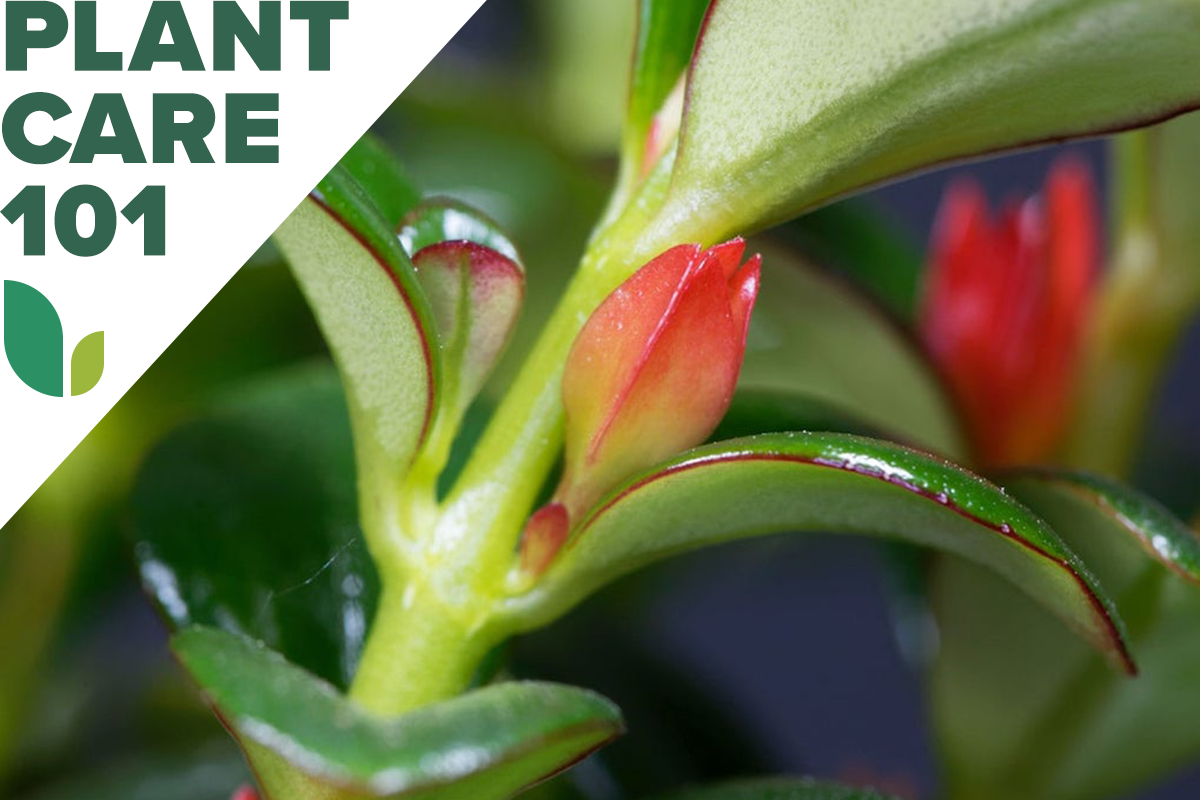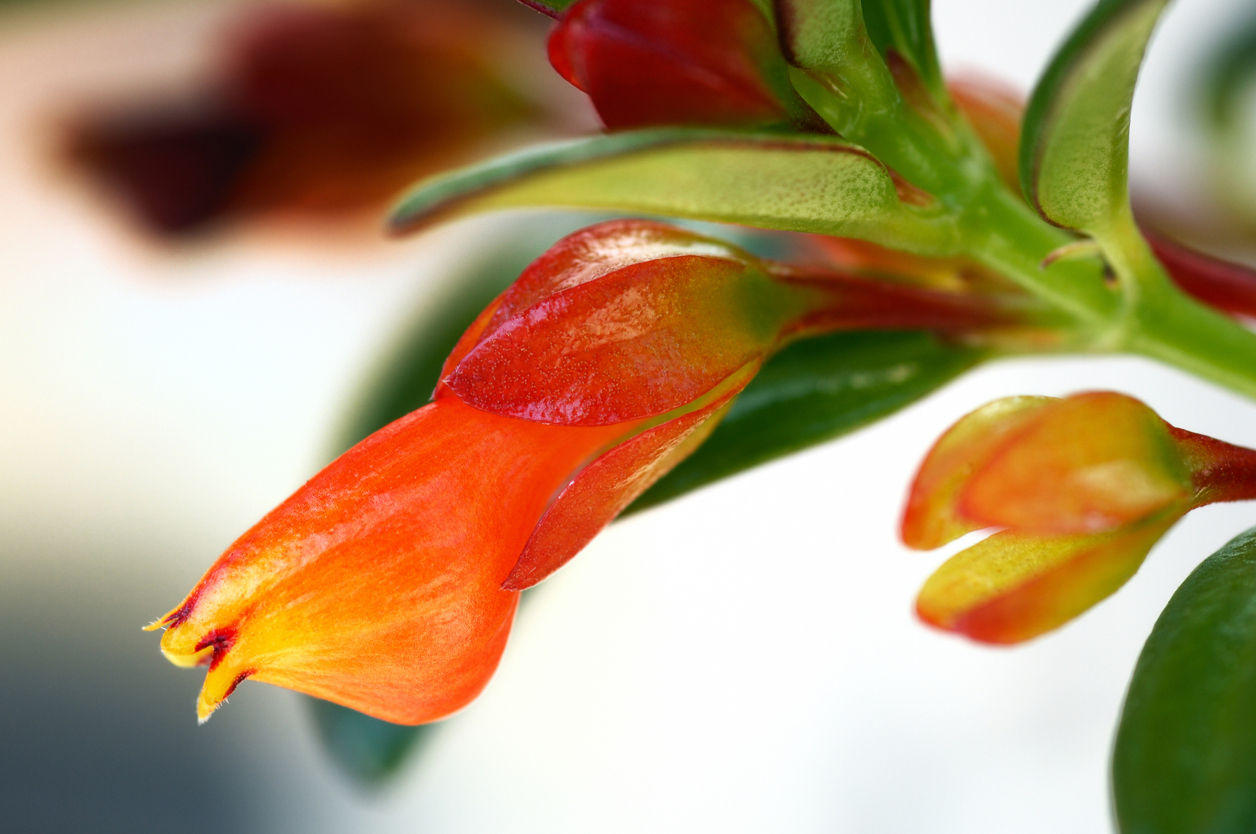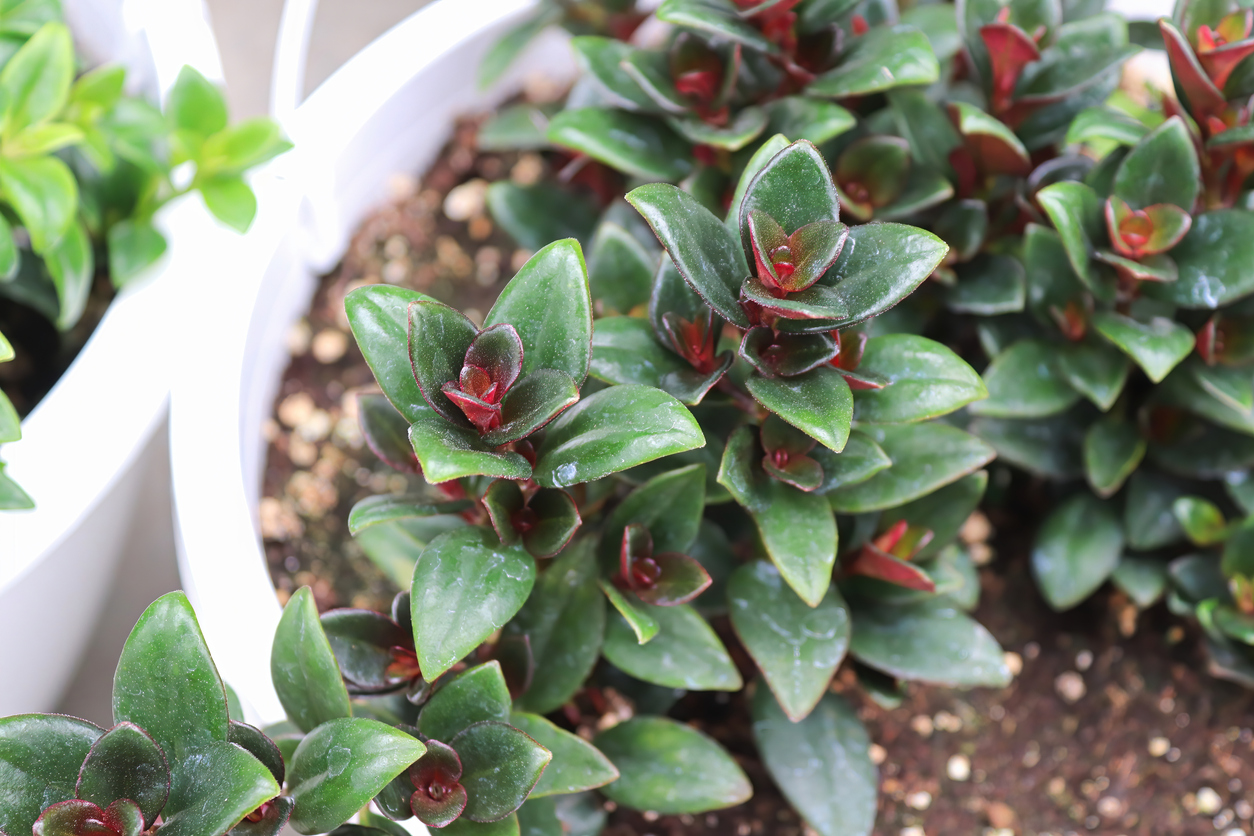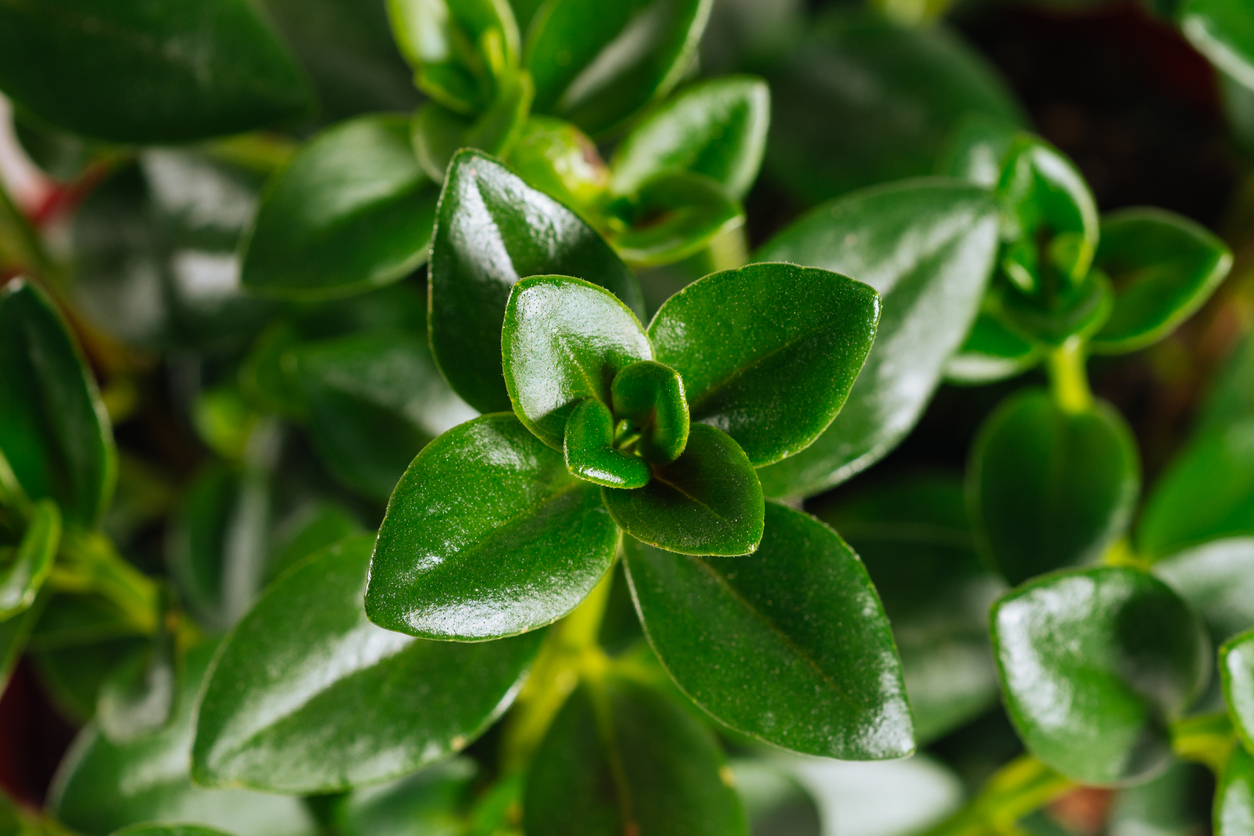

We may earn revenue from the products available on this page and participate in affiliate programs. Learn More ›
There are plenty of goldfish plants in the sea, er, market. The two related genus types that most often go by that name both are epiphytic vines, meaning they grow on trees in their native habitat.
The curving blooms of Columnea usually resemble leaping fish when viewed from the side, while the pouch-like flowers of Nematanthus simulate plump swimming fish. But some species of Columnea produce pouchy flowers, too, and people often confuse the two genera with each other. Fortunately, goldfish plant care is about the same for both types, and either can make a genuinely fine kettle of fish!
Goldfish Plant Care at a Glance
Common name: Goldfish plant
Scientific name: Columnea and Nematanthus species and hybrids
Soil: African violet soil
Light: Bright indirect light or morning sun
Water: Medium
Food: Low phosphorus or balanced fertilizer
Temperature and humidity: Likes humidity, dislikes excessive heat
Propagation: Cuttings
Safety: Not toxic
Goldfish Plant Characteristics
Known as dancing dolphin plant, shark plant, or goldfish plant for the blooms’ gaping mouths, the Columneas tend to have softer, hairier leaves than the Nematanthus genus’ succulent, glossy, and often red-backed ones, though some Columneas can be succulent, too. Their tumbling vines dangle between 3 feet (for C. gloriosa) and 6 feet (for C. arguta), while their red, orange, and/or yellow flowers extend about 3 inches in length.
The goldfish types of Nematanthus, on the other hand, seldom cascade farther than 2 feet with red, yellow, or pink blooms under 1 inch long. However, the “less fishy” species of both goldfish plant varieties produce flowers in a wide range of other shapes and colors as well. Outdoors, both genera are hardy in USDA Zones 11 and 12, though some types of Nematanthus may survive in Zone 10, too.
RELATED: 11 Head-Turning Houseplants You Won’t Believe Are Real.
Types of Goldfish Plant
• Columnea gloriosa: Probably the most common goldfish plant, this “glorious” one offers hairy purplish leaves accompanied by red and yellow blooms.
• Columnea hirta ‘Light Prince’: In this cultivar, white streaks of variegation on the foliage provide a royally bright background for the orange and yellow flowers.
• Nematanthus ‘Black Gold’: The black goldfish plant is named for the dusky green shade of its dark and glossy red-tinged leaves, which set off orange-yellow blooms.
• Nematanthus ‘Green Magic’: This green goldfish plant also seems to be named for the intense hue of its foliage rather than its flowers, which are bright orange.
• Nematanthus ‘Tropicana’: The tropical “fishes” decorating this cultivar flaunt red and orange stripes against dark-green leaves.

Selecting Goldfish Plant Soil
Like African violets, goldfish plants are gesneriads, a family of more than 3,200 species of tropical or subtropical plants with chiefly opposite leaves and highly zygomorphic flowers (essentially capable of dividing into symmetrical halves). Therefore, they do well in African violet potting soil with a pH between 5.8 and 6.2.
To make your own potting mix, combine two parts of peat moss with one part each of perlite and vermiculite. Then place your plant in a hanging basket from which it can dangle as it would from a tree. Nematanthus reportedly blooms best if kept a bit pot-bound, so refrain from repotting it too often.
The Right Light
These plants prefer bright indirect light, though they generally can thrive in an east-facing window as well, which receives only gentle morning sun. Nematanthus reportedly can take a little more heat and light than Columnea can, so you might want to try it in a west-facing window. However, if the leaves begin to brown, move it to a less bright location.
As with other gesneriads, these two thrive under fluorescent grow lights timed to run for 12 to 16 hours per day. Place the lights about 6 to 12 inches above the plants, and keep an eye on the plants’ color. Raise the lights farther away from foliage that looks pale and shrinking. Lower them closer to foliage that appears overly dark green and lanky. Grow lights work best when the plants are small, since keeping even illumination on all parts of a large hanging plant can be difficult.
Watering Goldfish Plants
Press your finger into the surface of your plant’s potting mix when you suspect it needs watering. If bits of soil cling to your finger, you should wait until the surface is dry before adding water. During winter, allow the mix to dry out a little farther down, perhaps to 1 inch, but never allow it to parch completely.
Because Columnea is sensitive to calcium, avoid watering it with hard tap water. If possible, use rainwater or purchased distilled water instead. Allow it to warm to room temperature before applying it to the soil at the outer edges of the pot.
Don’t pour water into the center of the plant since that can cause stem rot. Rather, insert your watering can’s spout beneath the foliage to avoid spattering it. Large drops of water—especially cold hard water—can cause unsightly spots on gesneriads’ leaves.
RELATED: Beyond Poinsettias: 23 Houseplants That Bloom in Winter.

Fertilizing Goldfish Plants
Since Columnea resents excessive phosphorus, you’ll want to fertilize it with a plant food low in that element, such as the 30-10-10 intended for acid-loving plants or (appropriately enough!) an organic fish emulsion high in nitrogen but low in phosphorus such as 5-1-1. (Keep in mind, though, that fish emulsion tends to have an unpleasant odor.)
Begin feeding your plant once every 2 weeks in spring, using half the recommended amount, and continue through late autumn. In winter, either reduce the feedings to once per month or suspend them altogether—depending on whether the plant is still growing at that time. Since phosphorus sensitivity isn’t mentioned for Nematanthus, you probably can get away with using a more balanced plant food for it.
Setting the Temperature and Humidity
Because goldfish plants prefer temperatures between 65 and 75 degrees Fahrenheit, it’s best to keep them indoors all year rather than moving them outdoors during summer, where they may suffer from the heat. Since they enjoy humidity, mist them every day with rainwater or distilled water, making sure the mist is fine enough that it doesn’t leave water spots on the leaves. Never spray them heavily enough to soak the foliage, as that can cause rot.
If a goldfish plant refuses to bloom at the appropriate time—generally from spring through autumn—try giving it cooler temperatures (54 to 59 degrees Fahrenheit) during winter until it sets buds. Don’t place the plant in a drafty location, however, as that can kill it.
Propagating Goldfish Plants
Goldfish plant propagation isn’t difficult. Simply cut 3-inch pieces from the ends of the stems, always snipping just below a leaf node. After filling a pot with seed-starting mix, use a pencil to make holes in it. Strip the lower foliage off the cuttings, leaving only a pair of leaves each at their tips. Dip their bases in a rooting powder or solution before inserting them into the holes, so that at least one leaf node is covered on each cutting.
After tamping the soil around the bases of the cuttings and encasing the pot inside a transparent plastic bag, place it in a warm location with bright indirect light. If your cuttings begin to make new growth, tug lightly on them to check their progress. When they seem firmly rooted, you can gradually begin removing the bag, leaving it off for a longer period of time each day.
Safety Considerations
Goldfish plants aren’t toxic. However, any hanging foliage can be somewhat dangerous since cats and toddlers like to pull on its dangling strands. So, you’ll want to make sure that the hook from which your plant hangs is secured firmly enough that the heavy basket can’t be yanked down onto somebody’s (or some tabby’s) head.
It’s also a good idea to pinch back the dangling stems to 18 inches to make the plants fuller as well as less easy for fumbling fingers and playful paws to reach. Also, make sure the basket has an attached drip pan to prevent dirty water from dribbling onto your clean floors.

RELATED: The Dos and Don’ts of Watering Plants.
Potential Pests and Diseases
Common goldfish plant problems include stem and/or root rot and cold damage. Rot causes the stems to shrivel or the roots to turn mushy. It can be prevented by more careful watering as detailed in that section above. Cold injury, on the other hand, usually causes leaves to fall. To avoid it, keep your plant away from poorly insulated windows, which can admit icy drafts, and don’t allow its foliage to touch glacial glass.
Cotton-like mealybugs occasionally show up on gesneriads as well. For fuzzy-leafed goldfish plants, try picking mealybugs off with tweezers. On types with glossy leaves, you can employ a cotton swab dipped in rubbing alcohol to dab them to death.
FAQs About Goldfish Plant Care
If you have lots of questions about goldfish plant swimming around in your head, check the list below to see whether it provides you with quick answers. If not, you may want to fish around in the more extensive information presented in the sections above to see what you can net.
Q. How much light does a goldfish plant need?
Goldfish plants prefer bright indirect light or sun from an east-facing window.
Q. Is a goldfish plant a succulent?
The leaves of some Columnea and Nematanthus species are succulent, while others are not.
Q. Do goldfish plants like to be outside?
No. Unless you live in a temperate climate where summertime temperatures seldom rise above 75 degrees Fahrenheit, you should keep your goldfish plants indoors.
Q. How long do goldfish plants live?
Goldfish plants can survive for 5 years or more, and longer if you propagate them regularly.
Looking for more low-light blooming plants? Check out our guides on caring for peace lily and shade-loving container plants.
